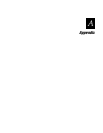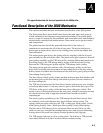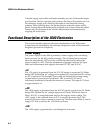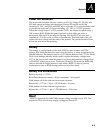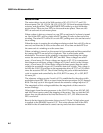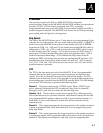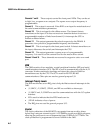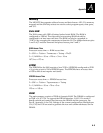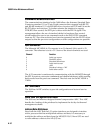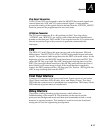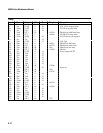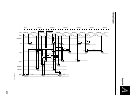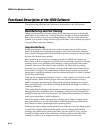
Appendix
A-7
A
Processor
The processor used in the 3600 is a MMC68332 32-bit integrated
microcontroller. Based on the MC68020, the MC68332 contains four peripheral
modules: CPU32, a 32-bit central processing unit; TPU, a complex,
programmable time processor unit; QSM, a queued serial module; and SIM, a
system integration module. The MC68332 was chosen for its 32-bit processing
power along with its high level of integration.
Chip Selects
The SIM of the MC68332 allows up to 12 chip selects to be programmed by the
software for use in the system. We use seven of these chip selects. /CSBOOT is
used to access the EPROM of the system. It can handle up to 1M of EPROM
organized as 512K x 16. /CS0 and CS1 are used for accessing DRAM, which is
configured as 512K x 16. /CS2 is used to access the static RAM, which is used
for font, format, and UDC storage. /CS3 is used to access the ASIC and I/O
option port. U23 then decodes these chip selects using address lines. /CS4 is
used for interrupt acknowledge. /CS5 combines the chip selects for both
loading the FIFO with image data and also for reading the DIP switches. U20
decodes these chip selects using address lines A16 and A17. /CS6 is used as
A19. /CS7, /CS8, and /CS9 are reserved to be used as A20, A21, and A22 for
possible memory expansion.
TPU
The TPU is the time processor unit of the MC68332. It has 16 programmable
channels that can be used to generate output waveforms or capture input
signals. All of the 16 channels are used in the 3600 printer design. The TPU
contains built-in functions, but it is also possible to override these functions by
downloading new functions into the MC68332 standby RAM. The 3600 design
uses custom TPU functions to perform the following tasks:
Channel 0 This input captures the /STPINT signal. When /STPINT goes
active, channel 0 interrupts the CPU to indicate a step, links to channels 1
through 6 and 10, and sets up a match for the half-step time.
Channels 1 to 4 These outputs control motor signals M1 to M4 respectively.
After initialization to set up motor direction, each channel outputs the next bit
of a programmable bit pattern whenever a link is received from channel 0. A
fixed delay is set for each channel to ensure that all four channels switch
simultaneously.
Channel 5 This output generates the duration portion of the strobe waveform.
A pulse is generated after a link from channel 0. You can program the pulse
delay and width.
Channel 6 This output generates the chopped portion of the strobe waveform.
A continuous square wave is generated and synchronized with each link from
channel 0. The square wave frequency and duty cycle are programmable.





